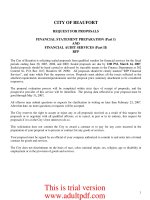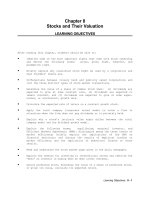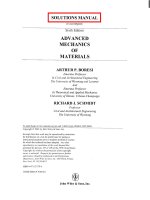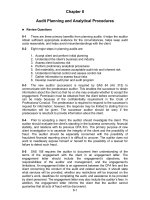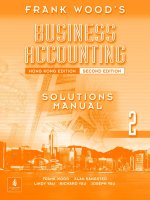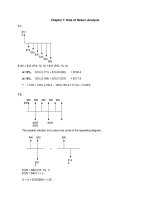Chapter 8 solutions 5th edition - Solution manual of Business Analysis & Valuation Using financial statement.
Bạn đang xem bản rút gọn của tài liệu. Xem và tải ngay bản đầy đủ của tài liệu tại đây (137.82 KB, 17 trang )
Chapter 8
Prospective Analysis: Valuation Implementation
Discussion Questions
1. How would the forecasts in Table 8-2 change if TJX were to maintain a sales growth rate of 10 percent per year from 2011 to 2020 (and all
the other assumptions are kept unchanged)?
Sales growth rate
NOPAT margin
WC to sales
LT assets to sales
Debt ratio
After tax cost of debt
2011
10.0%
7.9%
0.6%
33.4%
57.5%
2.73%
2012
10.0%
7.5%
1.0%
34.0%
57.5%
2.73%
2013
10.0%
7.1%
1.0%
34.3%
57.5%
2.73%
2014
10.0%
6.7%
1.0%
34.5%
57.5%
2.73%
2015
10.0%
6.3%
1.0%
34.8%
57.5%
2.73%
2016
10.0%
5.9%
1.0%
35.0%
57.5%
2.73%
2017
10.0%
5.5%
1.0%
35.3%
57.5%
2.73%
2018
10.0%
5.0%
1.0%
35.5%
57.5%
2.73%
2019
10.0%
4.5%
1.0%
35.8%
57.5%
2.73%
2020
10.0%
4.0%
1.0%
36.0%
57.5%
2.73%
24,1
36
1,9
07
1
24
1,7
83
26,5
50
1,9
91
1
46
1,8
46
29,2
05
2,0
74
1
61
1,9
12
32,1
26
2,1
52
1
79
1,9
74
35,3
38
2,2
26
1
98
2,0
28
38,8
72
2,2
93
2
19
2,0
74
42,7
59
2,3
52
2
43
2,1
09
47,0
35
2,3
52
2
69
2,0
82
51,7
39
2,3
28
2
98
2,0
30
56,9
12
2,2
77
3
30
1,9
46
1,78
3
1,84
6
1,91
2
1,97
4
2,02
8
2,07
4
2,10
9
2,08
2
2,03
0
1,946
Income Statement
Sales
Net operating profit after tax
- Net interest expense after tax
= Net Income
-
Preferred dividends
= Net income to common
© 2013 Cengage Learning. All Rights Reserved. May not be scanned, copied or duplicated, or posted to a publicly accessible website, in whole or in part.
2 Instructor’s Manual
© 2013 Cengage Learning. All Rights Reserved. May not be scanned, copied or duplicated, or posted to a publicly accessible website, in whole or in part.
Chapter 8 Prospective Analysis: Valuation Implementation 3
2011
2012
2013
2014
2015
2016
2017
2018
2019
2020
144
7,7
54
7,89
9
266
9,
027
9,2
93
292
10,
003
10,2
95
321
11,0
83
11,40
5
353
12,
280
12,6
33
389
13,
605
13,9
94
428
15,
073
15,5
00
470
16,
697
17,1
68
517
18,
497
19,0
14
569
20,
488
21,0
58
4,5
41
5,
343
5,
919
6,
557
7,
264
8,
046
8,
912
9,
871
10
,932
12
,107
3,3
57
3,
950
4,
376
4,
847
5,
370
5,
948
6,
588
7,2
97
8,0
82
8,9
50
Beginning Balance
Sheet
Beg. Net working capital
+
Beg. Net long-term assets
=
Net operating assets
Net debt
+
Preferred stock
+
Common stock
=
Net capital
Ratios
Operating return on assets
Return on equity
Book value of assets growth
Book value of equity growth
Net operating asset turnover
7,899
24.1%
53.1%
23.7%
16.2%
3.1
9,293
21.4%
46.7%
17.7%
17.7%
2.9
10,295
20.1%
43.7%
10.8%
10.8%
2.8
11,405
18.9%
40.7%
10.8%
10.8%
2.8
12,633
13,994
15,500
17,168
19,014
21,058
17.6%
37.8%
10.8%
10.8%
2.8
16.4%
34.9%
10.8%
10.8%
2.8
15.2%
32.0%
10.8%
10.8%
2.8
13.7%
28.5%
10.8%
10.8%
2.7
12.2%
25.1%
10.8%
10.8%
2.7
10.9%
21.7%
10.8%
10.8%
2.7
© 2013 Cengage Learning. All Rights Reserved. May not be scanned, copied or duplicated, or posted to a publicly accessible website, in whole or in part.
4 Instructor’s Manual
2011
2012
2013
2014
2015
2016
2017
2018
2019
2020
1,7
83
(12
1)
(1,
273)
80
2
1,
190
1,8
46
1,9
12
1,9
74
2,0
28
2,0
74
2,1
09
2,0
82
2,0
30
1,946
(27)
(976
)
57
6
1,
420
(29)
(1,0
81)
63
8
1,
440
(32)
(1,1
97)
70
7
1,
451
(35)
(1,3
25)
78
2
1,
450
(39)
(1,4
67)
86
6
1,
434
(43)
(1,6
25)
95
9
1,
400
(47)
(1,7
99)
1,
061
1,
298
(52)
(1,9
92)
1,
175
1,
161
1,9
91
2,0
74
2,1
52
2,2
26
2,2
93
2,3
52
2,3
52
2,3
28
(27)
(976
)
98
9
(29)
(1,0
81)
96
4
(32)
(1,1
97)
92
4
(35)
(1,3
25)
86
6
(39)
(1,4
67)
78
7
(43)
(1,6
25)
68
4
(47)
(1,7
99)
50
6
(52)
(1,9
92)
28
5
Cash flows
Net Income
-
Change in net working capital
-
Change in net long-term assets
+ Change in net debt
= Free cash flow to equity
Net operating profit after tax
-
Change in net working capital
-
Change in net long-term assets
= Free cash flow to capital
1,9
07
(12
1)
(1,
273)
51
3
Note: 2021 input values same as 2020.
© 2013 Cengage Learning. All Rights Reserved. May not be scanned, copied or duplicated, or posted to a publicly accessible website, in whole or in part.
(57)
(2,049)
1,211
1,051
2,277
(57)
(2,049)
171
Chapter 8 Prospective Analysis: Valuation Implementation 5
2. Recalculate the forecasts in Table 8-2 assuming that the NOPAT profit margin is held steady for the first five years of the forecast and then
declines by 0.1 percentage points per year thereafter (keeping all the other assumptions unchanged).
Sales growth rate
NOPAT margin
WC to sales
LT assets to sales
Debt ratio
After tax cost of debt
2011
5.7%
7.9%
0.6%
33.4%
57.5%
2.73%
2012
6.6%
7.9%
1.0%
34.0%
57.5%
2.73%
2013
7.1%
7.9%
1.0%
34.3%
57.5%
2.73%
2014
6.9%
7.9%
1.0%
34.5%
57.5%
2.73%
2015
6.7%
7.9%
1.0%
34.8%
57.5%
2.73%
2016
6.5%
7.8%
1.0%
35.0%
57.5%
2.73%
2017
6.3%
7.7%
1.0%
35.3%
57.5%
2.73%
2018
6.1%
7.6%
1.0%
35.5%
57.5%
2.73%
2019
5.9%
7.5%
1.0%
35.8%
57.5%
2.73%
2020
5.7%
7.4%
1.0%
36.0%
57.5%
2.73%
23,1
93
1,8
32
12
4
1,7
08
24,7
24
1,9
53
1
36
1,8
17
26,4
79
2,0
92
14
6
1,9
45
28,3
06
2,2
36
1
58
2,0
79
30,2
03
2,3
86
16
9
2,2
17
32,1
66
2,5
09
18
2
2,3
27
34,1
92
2,6
33
1
94
2,4
38
36,2
78
2,7
57
20
8
2,5
49
38,4
18
2,8
81
22
1
2,6
60
40,6
08
3,0
05
23
6
2,7
69
1,7
08
1,8
17
1,9
45
2,0
79
2,2
17
2,3
27
2,4
38
2,5
49
2,6
60
2,7
69
Income Statement
Sales
Net operating profit after tax
- Net interest expense after tax
= Net Income
-
Preferred dividends
= Net income to common
© 2013 Cengage Learning. All Rights Reserved. May not be scanned, copied or duplicated, or posted to a publicly accessible website, in whole or in part.
6 Instructor’s Manual
2011
2012
2013
2014
2015
2016
2017
2018
2019
2020
14
4
7,7
54
7,89
9
247
8,4
06
8,65
3
265
9,06
9
9,334
283
9,76
6
10,04
9
302
10,4
95
10,79
7
322
11,2
58
11,58
0
342
12,0
53
12,39
5
363
12,8
79
13,24
1
384
13,7
35
14,11
9
406
14,6
19
15,02
5
4,5
41
4,9
75
5,3
67
5,7
78
6,2
08
6,6
58
7,1
26
7,6
13
8,1
18
8,6
39
3,3
57
7,89
9
3,6
78
8,65
3
3,9
67
4,2
71
10,04
9
4,5
89
10,79
7
4,9
22
11,58
0
5,2
68
12,39
5
5,62
8
13,24
1
6,00
1
14,11
9
6,38
6
15,02
5
Beginning Balance Sheet
Beg. Net working capital
+ Beg. Net long-term assets
= Net operating assets
Net debt
+ Preferred stock
+ Common stock
= Net capital
Ratios
Operating return on assets
Return on equity
Book value of assets growth
Book value of equity growth
Net operating asset turnover
23.2%
50.9%
23.7%
16.2%
2.9
22.6%
49.4%
9.6%
9.6%
2.9
9,334
22.4%
49.0%
7.9%
7.9%
2.8
22.3%
48.7%
7.7%
7.7%
2.8
22.1%
48.3%
7.5%
7.5%
2.8
21.7%
47.3%
7.2%
7.2%
2.8
21.2%
46.3%
7.0%
7.0%
2.8
20.8%
45.3%
6.8%
6.8%
2.7
© 2013 Cengage Learning. All Rights Reserved. May not be scanned, copied or duplicated, or posted to a publicly accessible website, in whole or in part.
20.4%
44.3%
6.6%
6.6%
2.7
20.0%
43.4%
6.4%
6.4%
2.7
Chapter 8 Prospective Analysis: Valuation Implementation 7
2011
2012
2013
2014
2015
2016
2017
2018
2019
2020
1,70
8
(103
)
(652
)
43
4
1,3
88
1,81
7
(
18)
(663
)
39
1
1,5
28
1,94
5
(18)
2,07
9
(
19)
2,21
7
(
20)
2,32
7
(
20)
2,43
8
(
21)
2,54
9
(
21)
2,66
0
(
22)
2,76
9
(
23)
(697)
41
1
1,6
42
(730)
43
1
1,7
60
(763)
45
0
1,88
4
(795)
46
9
1,98
1
(826)
48
7
2,07
8
(856)
50
4
2,17
7
(884)
52
1
2,27
5
(833)
49
2
2,40
5
1,83
2
(103
)
(652
)
1,0
77
1,95
3
(
18)
(663
)
1,2
73
2,09
2
(18)
2,23
6
(
19)
2,38
6
(
20)
2,50
9
(
20)
2,63
3
(
21)
2,75
7
(
21)
2,88
1
(
22)
3,00
5
(
23)
(697)
1,3
77
(730)
1,4
87
(763)
1,6
04
(795)
1,6
94
(826)
1,7
86
(856)
1,8
80
(884)
1,9
75
(833)
2,1
49
Cash flows
-
Net Income
Change in net working
capital
Change in net long-term
assets
+ Change in net debt
= Free cash flow to equity
-
Net operating profit after tax
Change in net working
capital
Change in net long-term
assets
= Free cash flow to capital
Note: 2021 input values same as 2020.
© 2013 Cengage Learning. All Rights Reserved. May not be scanned, copied or duplicated, or posted to a publicly accessible website, in whole or in part.
8 Instructor’s Manual
3. Recalculate the forecasts in Tables 8-2 assuming that the ratio of net operating working capital to sales is 3 percent, and the ratio of net longterm assets to sales holds steady at 33.4 percent for all the years from fiscal 2011 to fiscal 2020. Keep all the other assumptions unchanged.
Sales growth rate
NOPAT margin
WC to sales
LT assets to sales
Debt ratio
After tax cost of debt
2011
5.7%
7.9%
0.6%
33.4%
57.5%
2.73%
2012
6.6%
7.5%
3.0%
33.4%
57.5%
2.73%
2013
7.1%
7.1%
3.0%
33.4%
57.5%
2.73%
2014
6.9%
6.7%
3.0%
33.4%
57.5%
2.73%
2015
6.7%
6.3%
3.0%
33.4%
57.5%
2.73%
2016
6.5%
5.9%
3.0%
33.4%
57.5%
2.73%
2017
6.3%
5.5%
3.0%
33.4%
57.5%
2.73%
2018
6.1%
5.0%
3.0%
33.4%
57.5%
2.73%
2019
5.9%
4.5%
3.0%
33.4%
57.5%
2.73%
2020
5.7%
4.0%
3.0%
33.4%
57.5%
2.73%
23,1
93
1,8
32
1
24
1,7
08
24,7
24
1,8
54
1
41
1,7
13
26,4
79
1,8
80
1
51
1,7
29
28,3
06
1,8
97
1
62
1,7
35
30,2
03
1,9
03
1
72
1,7
30
32,1
66
1,8
99
1
84
1,7
14
34,1
92
1,8
81
1
95
1,6
85
36,2
78
1,8
14
2
07
1,6
07
38,4
18
1,7
29
2
19
1,5
09
40,6
08
1,6
24
2
32
1,3
92
1,7
08
1,7
13
1,7
29
1,7
35
1,7
30
1,7
14
1,6
85
1,6
07
1,5
09
1,3
92
Income Statement
Sales
Net operating profit after tax
- Net interest expense after tax
= Net Income
-
Preferred dividends
= Net income to common
© 2013 Cengage Learning. All Rights Reserved. May not be scanned, copied or duplicated, or posted to a publicly accessible website, in whole or in part.
Chapter 8 Prospective Analysis: Valuation Implementation 9
2011
2012
2013
2014
2015
2016
2017
2018
2019
2020
849
965
10,74
3
1,02
6
11,42
0
1,08
8
12,11
7
1,15
3
12,83
2
1,21
8
13,56
3
Beginning Balance Sheet
Beg. Net working capital
+
Beg. Net long-term assets
=
Net operating assets
Net debt
+
Preferred stock
+
Common stock
=
Net capital
Ratios
Operating return on assets
Return on equity
Book value of assets growth
Book value of equity growth
Net operating asset turnover
144
.1
7,7
54
7,89
9
742
8,25
8
794
8,84
4
9,454
906
10,08
8
8,999
9,638
10,303
10,994
11,708
12,446
13,205
13,984
14,781
4,5
41
5,1
74
5,5
42
5,92
4
6,32
1
6,73
2
7,15
6
7,59
3
8,04
0
8,49
9
3,3
57
7,89
9
3,8
25
4,0
97
4,37
9
-
-
-
-
-
-
4,673
4,976
5,290
5,613
5,944
6,283
8,999
9,638
10,303
10,994
11,708
12,446
13,205
13,984
14,781
23.2%
50.9%
23.7%
16.2%
2.9
20.6%
44.8%
13.9%
13.9%
2.8
19.5%
42.2%
7.1%
7.1%
2.8
18.4%
39.6%
6.9%
6.9%
2.8
17.3%
37.0%
6.7%
6.7%
2.8
16.2%
34.4%
6.5%
6.5%
2.8
15.1%
31.9%
6.3%
6.3%
2.8
13.7%
28.6%
6.1%
6.1%
2.8
© 2013 Cengage Learning. All Rights Reserved. May not be scanned, copied or duplicated, or posted to a publicly accessible website, in whole or in part.
12.4%
25.4%
5.9%
5.9%
2.8
11.0%
22.2%
5.7%
5.7%
2.8
10 Instructor’s Manual
Cash flows
Net Income
-
Change in net working capital
-
Change in net long-term assets
+
Change in net debt
=
Free cash flow to equity
Net operating profit after tax
-
Change in net working capital
-
Change in net long-term assets
=
Free cash flow to capital
2011
2012
2013
2014
2015
2016
2017
2018
2019
2020
1,7
08
(598
)
(503
)
1,7
13
(53
)
(586
)
36
7
1,
442
1,7
29
(55
)
(610
)
38
2
1,
446
1,7
35
(57
)
(633
)
39
7
1,
441
1,7
30
(59
)
(656
)
41
1
1,
427
1,7
14
(61
)
(677
)
42
4
1,
401
1,6
85
(63
)
(697
)
43
7
1,
363
1,6
07
(64
)
(715
)
44
8
1,
276
1,5
09
(66
)
(731
)
45
8
1,
171
1,3
92
(69
)
(773
)
48
4
1,
034
2012
1,8
54
(53
)
(586
)
1,
215
2013
1,8
80
(55
)
(610
)
1,
215
2014
1,8
97
(57
)
(633
)
1,
206
2015
1,9
03
(59
)
(656
)
1,
188
2016
1,8
99
(61
)
(677
)
1,
160
2017
1,8
81
(63
)
(697
)
1,
121
2018
1,8
14
(64
)
(715
)
1,
035
2019
1,7
29
(66
)
(731
)
93
2
2020
1,6
24
(69
)
(773
)
78
2
633
1,24
0
2011
1,8
32
(598
)
(503
)
731
Note: 2021 input values same as 2020. Also, net operating working capital to sales ratio for 2011 is an actual.
© 2013 Cengage Learning. All Rights Reserved. May not be scanned, copied or duplicated, or posted to a publicly accessible website, in whole or in part.
Chapter 8 Prospective Analysis: Valuation Implementation 11
4. Calculate TJX’s cash payouts to its shareholders in the years 2011–2020 that are implicitly assumed in the projections in Table 8-2.
The cash payouts made to shareholders are simply the free cash flows to equity. These are the surplus cash flows available after
reinvesting needed funds in working capital and assets. The values are presented in Table 8-2 and are $1,387.6 in 2011, declining to
$1,024.7 in 2020.
5. How would the abnormal earnings calculations in Table 8-3 change if the cost of equity assumption is changed to 12%?
2011
2012
2013
2014
2015
2016
2017
2018
2019
2020
1,
305
38.9%
1,
277
34.7%
1,
257
31.7%
1,
226
28.7%
1,
183
25.8%
1,
125
22.9%
1,
054
20.0%
93
1
16.5%
78
7
13.1%
62
2
9.7%
Equity Valuation
Abnormal earnings
Abnormal ROE
© 2013 Cengage Learning. All Rights Reserved. May not be scanned, copied or duplicated, or posted to a publicly accessible website, in whole or in part.
12 Instructor’s Manual
6. What would be the total equity value (as calculated for scenarios in Table 8-6 using abnormal earnings) if the sales growth in years 2021 and
beyond is 8.5 percent and the company is able to generate abnormal returns at the same level as in fiscal 2020 forever (keeping all the other
assumptions in the table unchanged)?
Sales growth rate
NOPAT margin
WC to sales
LT assets to sales
Debt ratio
After tax cost of debt
2011
5.7%
7.9%
0.6%
33.4%
57.5%
2.73%
2012
6.6%
7.5%
1.0%
34.0%
57.5%
2.73%
2013
7.1%
7.1%
1.0%
34.3%
57.5%
2.73%
2014
6.9%
6.7%
1.0%
34.5%
57.5%
2.73%
2015
6.7%
6.3%
1.0%
34.8%
57.5%
2.73%
2016
6.5%
5.9%
1.0%
35.0%
57.5%
2.73%
2017
6.3%
5.5%
1.0%
35.3%
57.5%
2.73%
2018
6.1%
5.0%
1.0%
35.5%
57.5%
2.73%
2019
5.9%
4.5%
1.0%
35.8%
57.5%
2.73%
2020
5.7%
4.0%
1.0%
36.0%
57.5%
2.73%
2021
8.5%
4.0%
1.0%
36.0%
57.5%
2.73%
23,1
93
1,8
32
1
24
1,7
08
24,7
24
1,8
54
1
36
1,7
19
26,4
79
1,8
80
1
46
1,7
34
28,3
06
1,8
97
1
58
1,7
39
30,2
03
1,9
03
1
69
1,7
33
32,1
66
1,8
98
1
82
1,7
16
34,1
92
1,8
81
1
94
1,6
86
36,2
78
1,8
14
2
08
1,6
06
38,4
18
1,7
29
2
21
1,5
07
40,6
08
1,6
24
2
36
1,3
89
44,06
0
1,7
08
1,7
19
1,7
34
1,7
39
1,7
33
1,7
16
1,6
86
1,6
06
1,5
07
1,3
89
Income Statement
Sales
Net operating profit after tax
- Net interest expense after tax
= Net Income
-
Preferred dividends
= Net income to common
© 2013 Cengage Learning. All Rights Reserved. May not be scanned, copied or duplicated, or posted to a publicly accessible website, in whole or in part.
1,762
256
1,507
1,507
Chapter 8 Prospective Analysis: Valuation Implementation 13
2011
2012
2013
2014
2015
2016
2017
2018
2019
2020
2021
1
44
7
,754
7,
989
247
8,
406
8,6
53
265
9,
069
9,3
34
283
9,76
6
10,04
9
302
10,4
95
10,79
7
322
11,2
58
11,58
0
342
12,0
53
12,39
5
363
12,8
79
13,24
1
384
13,7
35
14,11
9
406
14,6
19
15,02
5
441
4
,541
4,
975
5,367
5,7
78
6,2
08
6,6
58
7,1
26
7,6
13
8,1
18
8,6
39
3
,357
7,
899
3,
678
8,6
53
3,967
9,3
34
4,2
71
10,04
9
4,5
89
10,79
7
4,9
22
11,58
0
5,2
68
12,39
5
5,62
8
13,24
1
6,00
1
14,11
9
6,38
6
15,02
5
23.2%
50.9%
21.4%
46.7%
20.1%
43.7%
18.9%
40.7%
17.6%
37.8%
16.4%
34.9%
15.2%
32.0%
13.7%
28.5%
12.2%
25.1%
10.8%
21.7%
10.8%
21.7%
23.7%
9.6%
7.9%
7.7%
7.5%
7.2%
7.0%
6.8%
6.6%
6.4%
8.5%
16.2%
9.6%
7.9%
7.7%
7.5%
7.2%
7.0%
6.8%
6.6%
6.4%
8.5%
2.9
2.9
2.8
2.8
2.8
2.8
2.8
2.7
2.7
2.7
2.7
Beginning Balance Sheet
Beg. Net working capital
+ Beg. Net long-term assets
= Net operating assets
Net debt
+ Preferred stock
+ Common stock
= Net capital
Ratios
Operating return on assets
Return on equity
Book value of assets
growth
Book value of equity
growth
Net operating asset
turnover
-
© 2013 Cengage Learning. All Rights Reserved. May not be scanned, copied or duplicated, or posted to a publicly accessible website, in whole or in part.
15,862
16,302
9,373
6,929
16,302
14 Instructor’s Manual
Valuation
Abnormal earnings
2011
1,4
14
Discount factor
Present value of
abnormal earnings
0.92
1,3
00
Beginning book value
3,357
PV abnormal earnings
2011 to 2020
8,24
7
PV abnormal earnings
2021 on
143,6
53
Total equity value of
TJX
155,2
57
2012
1
,396
0.
85
1
,180
2013
2014
2015
2016
1,386
0
.78
1,364
0.71
1,331
0
.66
1,285
0
.60
1,077
975
874
776
2017
1
,224
0.
56
6
80
2018
1
,113
0.
51
5
68
2019
2020
981
0
.47
829
0
.43
460
357
2021
8
99
0.
43
3
88
The 8.5% terminal growth rate leads the terminal value to explode, since the cost of equity is 8.77%. The denominator in the terminal value
perpetuity is then .0877-.085 or .0027. This is clearly an unreasonable assumption that grossly overvalues TJX.
© 2013 Cengage Learning. All Rights Reserved. May not be scanned, copied or duplicated, or posted to a publicly accessible website, in whole or in part.
Chapter 8 Prospective Analysis: Valuation Implementation 15
7. Calculate the proportion of terminal value to total estimated value of equity under the abnormal earnings method and the
discounted cash flow method for the Scenario 2 results shown in Table 8-6. Why are these proportions different?
Under the abnormal earnings method, the terminal value in Table 8-6 comprises 35.5% of the total value (6381.3/17985.1). In contrast,
the terminal in the free cash flow to equity method is 51.3% of the total value (9219.2/17985.1). The reason for the difference is that the
abnormal earnings method contains the current book value of equity as its base, and then counts only superior earnings each year. By the
terminal years, given competition, this superior performance is expected to be modest. In contrast, the free cash flow method values the
full cash flows to shareholders, whether they are generated by normal of abnormal performance. The cash flows therefore grow steadily
during the terminal value period, even though much of this performance reflects merely a normal return on capital.
8.
What will TJX’s cost of equity be if the equity market risk premium is 5 percent?
Market risk premium
∗ Common equity beta
5.0%
0.8
4.0%
+ Risk free rate
3.4%
= Cost of common equity
7.4%
9. Assume that TJX changes its capital structure so that its market value weight of debt to capital increases to 30%, and its after-tax
interest rate on debt at this new leverage level is 3.5%. Assume that the equity market risk premium is 6.7%. What will be the cost of
equity at the new debt level? What will be the new weighted average cost of capital?
© 2013 Cengage Learning. All Rights Reserved. May not be scanned, copied or duplicated, or posted to a publicly accessible website, in whole or in part.
16 Instructor’s Manual
The first task is to compute the new equity beta. The beta of TJX’s assets will not change, since its assets are unchanged. But the equity
beta will increase somewhat to reflect the increased financial risk faced by shareholders. Under the prior capital structure, where the pretax cost of debt was 4.4%, the risk premium was 6.7% and the risk free rate was 3.41%, TJX’s debt beta was (4.4%-3.41%)/6.7% or 0.15.
Given its equity beta of 0.8 and its debt weighting of 20%, the asset beta for the company was as follows:
Asset beta = Equity beta * (1 - Debt weight) + Debt beta * (Debt weight)
= 0.8*.8 + 0.15*.2 = 0.67
Under the new capital structure, the debt beta will increase. If the after-tax cost of debt is 3.5%, and the tax rate is 38%, the pre-tax cost
of debt is 5.65%, and the debt beta will be (5.65%-3.41%)/6.7% or 0.33. The adjusted equity beta is then as follows
Equity beta = [Asset beta – Debt beta * (Debt weight)]/(1-Debt weight)
= [0.67 - .33*0.3]/0.7 = 0.82
Given the modest change in capital structure, the change in equity beta is very small – probably not worth worrying about.
The revised cost of equity and WACC will then be as follows:
Cost of Equity
Market risk premium
6.7%
∗ Common equity beta
0.82
5.5%
+ Risk free rate
3.41%
= Cost of common equity
8.91%
© 2013 Cengage Learning. All Rights Reserved. May not be scanned, copied or duplicated, or posted to a publicly accessible website, in whole or in part.
Chapter 8 Prospective Analysis: Valuation Implementation 17
Weighted Average Cost of
Capital
After tax cost of debt
∗ Debt weight
3.5%
30.0%
+
Cost of common equity
8.91%
∗ (1-Debt weight)
70.0%
= Weighted Average Cost of Capital
7.3%
The insight for students here is to note that making modest changes in capital structure will not make a material difference in the firm’s
cost of equity or WACC.
10. Nancy Smith says she is uncomfortable making the assumption that TJX’s dividend payout will vary from year to year. If she
makes a constant dividend payout assumption, what changes does she have to make in her other valuation assumptions to make them
internally consistent with each other?
If Nancy Smith doesn’t want to allow dividend payout to vary across the years, then she can hold the dividend payout constant. However,
then she will have to allow for the capital structure to vary from year to year, since a constant dividend payout may not result in a stream
of equity values that will result in a constant debt-to-equity ratio. If the capital structure is allowed to vary, then the cost of capital will
vary in each period as well.
© 2013 Cengage Learning. All Rights Reserved. May not be scanned, copied or duplicated, or posted to a publicly accessible website, in whole or in part.
